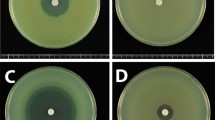Abstract
Thirty-sevenEnterococcus faecium strains were screened for high-level aminoglycoside resistance with an agar diffusion test using high-content aminoglycoside disks (300 μg of streptomycin and 120 μg of gentamicin, tobramycin, kanamycin or amikacin). The inhibition zones obtained were correlated with results of time-kill penicillin-aminoglycoside synergy studies. An 11 mm breakpoint differentiated strains susceptible or resistant to the synergy of streptomycin plus penicillin. Irrespective of the inhibition zones obtained with tobramycin and kanamycin disks,Enterococcus faecium strains never showed synergy with penicillin in combination with these aminoglycosides. Penicillin-amikacin synergy cannot be predicted by the amikacin disks. Nevertheless, even though kanamycin disks do not predict penicillin-kanamycin synergy, they can be used to predict penicillinamikacin synergy. In summary, high-content streptomycin, gentamicin and kanamycin disks can be used to predict the susceptibility ofEnterococcus faecium strains to the synergistic combination of penicillin plus one of the aminoglycosides (streptomycin, gentamicin or amikacin, respectively).
Similar content being viewed by others
References
Murray BE: The life and times of theEnterococcus. Clinical Microbiological Reviews 1990, 3: 46–65.
Moellering RC, Weinberg AN: Studies on antibiotic synergism against enterococci. II. Effect of various antibiotics on the uptake of14C-labeled streptomycin by enterococci. Journal of Clinical Investigation 1971, 50: 2580–2584.
Zimmerman RA, Moellering RC, Weinberg AN: Mechanism of resistance to antibiotic synergism in enterococci. Journal of Bacteriology 1971, 105: 873–879.
Watanakunakorn C, Bakie C: Synergism of vancomycin-gentamicin and vancomycin-streptomycin against enterococci. Antimicrobial Agents and Chemotherapy 1973, 4: 120–124.
Leclerq R, Dutka-Malen S, Brisson-Noel A, Molinas C, Derlot E, Arthur M, Duval J, Courvalin P: Resistance of enterococci to aminoglycosides and glycopeptides. Clinical Infectious Diseases 1992, 15: 495–501.
Moellering RC, Korzeniowski OM, Sande MA, Wennersten CB: Species-specific resistance to antimicrobial synergism inStreptococcus faecium andStreptococcus faecalis. Journal of Infectious Diseases 1979, 140: 203–208.
Eliopoulos GM, Wennersten C, Zighelboim-Duam S, Reiszner E, Goldmann D, Moellering RC: High-level aminoglycoside resistance to gentamicin in clinical isolates ofStreptococcus (Enterococcus) faecium. Antimicrobial Agents and Chemotherapy 1988, 32: 1528–1532.
Carlier C, Courvalin P: Emergence of 4′,4″-aminoglycoside nucleotidyltransferase in enterococci. Antimicrobial Agents and Chemotherapy 1990, 34: 1565–1569.
Sahm DF, Torres C: High-content aminoglycoside disks for determining aminoglycoside-penicillin synergy againstEnterococcus faecalis. Journal of Clinical Microbiology 1988, 26: 257–260.
Costa Y, Galimand M, Leclercq R, Duval J, Courvalin P: Characterization of the chromosomalaac(6′)-li gene specific forEnterococcus faecium. Antimicrobial Agents and Chemotherapy 1993, 37: 1896–1903.
Grayson ML, Eliopoulos GM, Wennersten CB, Ruoff KL, De Girolami PC, Ferraro MJ, Moellering RC: Increasing resistance to β-lactam antibiotics among clinical isolates ofEnterococcus faecium: a 22 year review at one institution. Antimicrobial Agents and Chemotherapy 1991, 35: 2180–2184.
Torres C, Tenorio C, Lantero M, Gastanares MJ, Baquero F: High-level penicillin resistance and penicillin-gentamicin synergy inEnterococcus faecium. Antimicrobial Agents and Chemotherapy 1993, 37: 2427–2431.
Sahm DF, Boonlayangoor S, Schulz JE: Detection of high-level aminoglycoside resistance in enterococci other thanEnterococcus faecalis. Journal of Clinical Microbiology 1991, 29: 2595–2598.
Facklam RR, Collins MD: Identification ofEnterococcus species isolated from human infections by a conventional test scheme. Journal of Clinical Microbiology 1989, 27: 731–734.
National Committee for Clinical Laboratory Standards: Methods for dilution antimicrobial susceptibility testing for bacteria that grow aerobically. Approved standard M7-A3. NCCLS, Villanova, PA, 1993.
Sahm DF, Torres C: Effects of medium and inoculum variations on screening for high-level aminoglycoside resistance inEnterococcus faecalis. Journal of Clinical Microbiology 1988, 26: 250–256.
Ferretti JJ, Gilmore KS, Courvalin P: Nucleotide sequence analysis of the gene specifying the bifunctional 6'-aminoglycoside acetyltransferase 2″-aminoglycoside phosphotransferase enzyme inStreptococcus faecalis and identification and cloning of gene regions specifying the two activities. Journal of Bacteriology 1986, 167: 631–638.
Author information
Authors and Affiliations
Rights and permissions
About this article
Cite this article
Torres, C., Tenorio, C., Lantero, M. et al. Detection of aminoglycoside-penicillin synergy againstEnterococcus faecium using high-content aminoglycoside disks. Eur. J. Clin. Microbiol. Infect. Dis. 14, 878–882 (1995). https://doi.org/10.1007/BF01691494
Issue Date:
DOI: https://doi.org/10.1007/BF01691494




